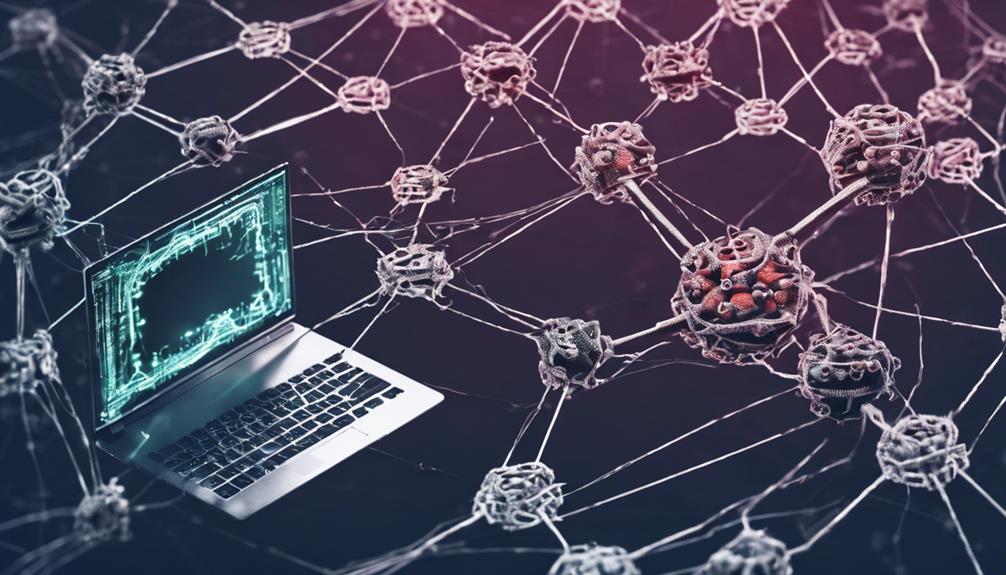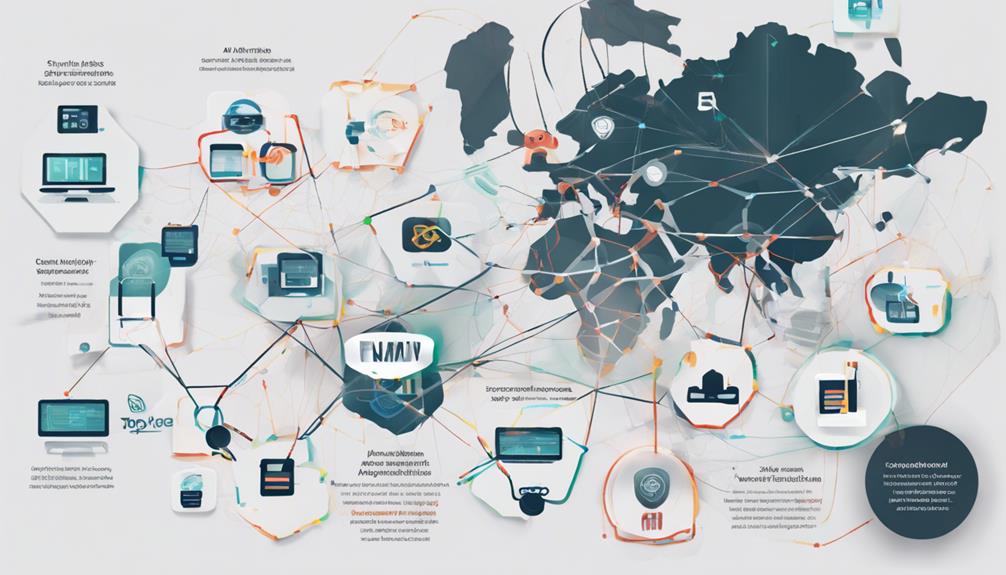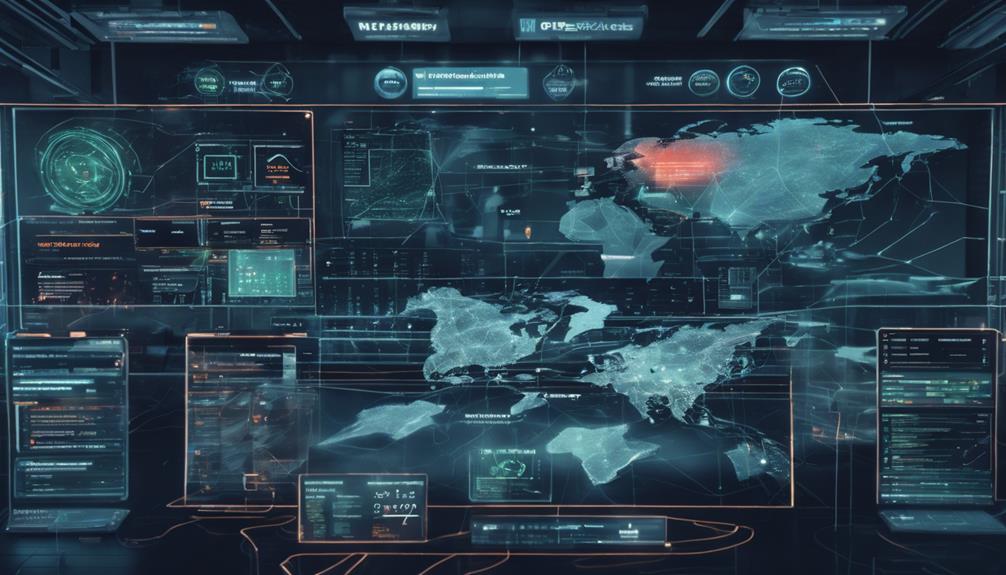Malicious bots present cybersecurity risks by infiltrating systems unnoticed and exploiting vulnerabilities to launch automated attacks. They spread malware, engage in identity theft, and participate in botnets for harmful actions. Disrupting operations, compromising data integrity, causing financial losses, and demanding stringent cybersecurity measures are their impacts. Protecting against them requires constant monitoring, updating systems, and using robust security software. Understanding these threats is vital for safeguarding sensitive data and networks. More insights into safeguarding against malicious bots are available through further exploration of cybersecurity practices.
Key Takeaways
- Infiltrate systems undetected by mimicking human behavior.
- Exploit vulnerabilities to execute automated attacks.
- Distribute malware through infected links and attachments.
- Facilitate identity theft and fraudulent activities.
- Disrupt operations and compromise data integrity.
Infiltrate Systems Undetected
Malicious bots, with their ability to mimic human behavior and evade traditional security measures, can infiltrate systems undetected, posing significant cybersecurity risks.
These sophisticated bots have the capability to bypass authentication processes, gaining unauthorized access to sensitive data and resources within a system. Once inside, they operate stealthily, executing harmful activities without triggering security alarms.
This clandestine presence enables malicious bots to gather information, manipulate data, or launch attacks without immediate detection, jeopardizing the integrity and confidentiality of sensitive data.
Detecting and mitigating the impact of these infiltrated bots necessitate advanced security measures and continuous monitoring to identify any unauthorized access or suspicious activities promptly.
Organizations need to implement robust security protocols and invest in technologies that can effectively detect and neutralize these malicious bots to safeguard their systems and prevent potential data breaches.
Exploit Vulnerabilities for Attacks

To compromise systems and initiate automated attacks, malicious bots leverage existing vulnerabilities within software and hardware infrastructures. These vulnerabilities serve as entry points for the bots to exploit, granting them unauthorized access to sensitive information or control over systems.
By targeting weaknesses in software or hardware, malicious bots can execute automated attacks aimed at causing harm, stealing data, or disrupting operations. This exploitation of vulnerabilities poses significant cybersecurity risks, as it allows these bots to operate undetected and carry out malicious activities without proper authorization.
Protecting against these threats requires organizations to regularly update and patch their systems to address known vulnerabilities. Implementing robust security measures, such as firewalls, intrusion detection systems, and access controls, can help mitigate the risks posed by malicious bots.
Additionally, educating users about cybersecurity best practices and the dangers of interacting with suspicious links or downloads can further enhance defenses against automated attacks orchestrated by these malicious entities.
Spread Malware and Viruses

Malicious bots are adept at spreading malware and viruses, posing significant risks to individuals and organizations. By distributing malware through infected links and attachments, these bots can compromise system security and lead to data breaches.
Understanding the methods of malware distribution and the risks associated with virus transmission is essential for implementing effective cybersecurity measures.
Malware Distribution Methods
Various methods are employed by malicious bots to distribute malware and viruses, posing significant cybersecurity risks to individuals and organizations. These bots use tactics such as phishing emails, infected attachments, malicious links, and drive-by downloads to infiltrate systems and spread harmful code. Exploiting vulnerabilities in software and networks, they can cause data breaches, financial losses, system disruptions, and compromised security. Malicious bots are capable of propagating ransomware, spyware, adware, trojans, and other types of malware, amplifying the potential damage they can inflict. To combat this threat, it is crucial to implement robust cybersecurity measures, keep software up to date, educate users about online dangers, and deploy trusted antivirus solutions.
| Malware Distribution Methods | Description | Impact |
|---|---|---|
| Phishing emails | Deceptive emails with malicious links or attachments | Can lead to stolen data and compromised systems |
| Infected attachments | Malware disguised as innocuous files | Enables the infiltration of devices and networks |
| Drive-by downloads | Automatic downloads of malware from websites | Infects systems without user interaction |
Virus Transmission Risks
The transmission of malware and viruses by malicious bots presents severe cybersecurity risks due to their ability to infect systems and propagate harmful code. Malicious bots can exploit vulnerabilities in software and networks to facilitate the spread of harmful viruses, compromising system integrity and data security.
Here are some key points to keep in mind regarding virus transmission risks:
- Malicious bots are adept at spreading malware and viruses by infecting systems and distributing malicious code.
- They can participate in botnets, amplifying the transmission of malware across interconnected devices.
- Identity theft through malicious bots can lead to the compromise of personal and sensitive information, increasing cybersecurity risks.
- The transmission of viruses and malware by these bots poses significant threats to both data security and system integrity.
- It is essential to implement robust cybersecurity measures to detect and prevent the spread of malware and viruses by malicious bots, safeguarding against potential cyber threats.
Engage in Identity Theft

Malicious bots pose a significant threat to individuals and organizations by engaging in identity theft. They can compromise personal data, leading to data breaches with severe financial implications.
Understanding the risks associated with identity theft by malicious bots is crucial for implementing effective cybersecurity measures.
Data Breach Risks
Cybersecurity threats involving data breaches present a significant risk for individuals as malicious bots are increasingly utilized to engage in identity theft. Malicious bots, when involved in data breaches, can lead to severe consequences such as compromised accounts, financial losses, and the misuse of personal information.
Here are some key points to contemplate:
- Malicious bots have the capability to steal personal information, including login credentials and financial data, contributing to identity theft.
- Identity theft through malicious bots can result in fraudulent activities carried out using the victim's compromised accounts and lead to financial losses.
- Cybercriminals leverage malicious bots to gather sensitive information like social security numbers and credit card details, enabling them to impersonate legitimate users.
- These bots can exploit personal identification data to access confidential information, perpetrate fraud, and manipulate online accounts.
- By engaging in identity theft, malicious bots create false identities, make unauthorized transactions, and exploit individuals' personal and financial information for malicious purposes.
Financial Fraud Implications
Engaging in identity theft through malicious bots poses significant financial fraud risks, exploiting personal information for illicit monetary gain. Malicious bots, by infiltrating systems and extracting sensitive data like credit card details and social security numbers, enable unauthorized access to financial accounts. This access paves the way for malicious bots to conduct fraudulent transactions, manipulating victims' identities for financial benefit through various deceitful tactics.
As a result, individuals and organizations face dire consequences, including substantial monetary losses due to the detrimental impact of these fraudulent activities. The exploitation of personal information by malicious bots not only jeopardizes financial security but also erodes trust in digital transactions.
It is essential for individuals and businesses to remain vigilant, implementing robust cybersecurity measures to safeguard against identity theft and mitigate the risks of falling victim to financial fraud orchestrated by these insidious bots.
Participate in Botnets for Harm

Participating in botnets for harm involves malicious bots joining forces in coordinated attacks orchestrated through a central server. This collaboration allows cybercriminals to leverage the combined power of multiple bots to amplify the impact of their malicious activities.
Here are some key points to understand about how bots in botnets pose a cybersecurity risk:
- Botnets: Networks of compromised devices controlled by a central server.
- Coordinated Attacks: Enable bots to collaborate in DDoS attacks, spam campaigns, and other harmful activities.
- Disruption: Used to overwhelm websites, servers, and networks with traffic to disrupt services.
- Amplified Impact: Cybercriminals harness multiple bots to intensify the scale and reach of their attacks.
- Detection Evasion: By operating collectively, bots in botnets can evade detection more effectively, heightening the risk they pose to cybersecurity.
The utilization of botnets by malicious actors underscores the critical need for robust cybersecurity measures to combat these coordinated threats effectively.
Disrupt Operations and Services

Malicious bots disrupt operations and services by flooding websites with fake traffic, causing slowdowns or crashes that result in downtime and revenue loss. This form of cyberattack poses significant cybersecurity risks to businesses, as the compromised system integrity can lead to data breaches and financial losses.
Beyond just slowing down websites, these bots can manipulate online inventory, creating false scarcity or impacting pricing strategies. The consequences of such disruptions extend beyond financial losses; they can also damage the reputation of businesses and result in customer dissatisfaction.
To mitigate the impact of malicious bots, organizations need to implement robust cybersecurity measures, including advanced bot detection systems and regular security audits. By staying vigilant and proactive in defending against these threats, businesses can safeguard their operations and services from the disruptive effects of fake traffic generated by malicious bots.
Compromise Data Integrity

Disrupting operations and services is just one way malicious bots threaten businesses; compromising data integrity is another critical cybersecurity risk they present. Malicious bots have the capability to compromise data integrity in various ways, posing serious threats to organizations. Here are some key points to take into account:
- Malicious bots can steal sensitive information, including login credentials and personal data, jeopardizing data integrity.
- By manipulating data within systems, these bots can introduce inaccuracies, potentially damaging the integrity of stored information.
- Data confidentiality is at risk as malicious bots can exfiltrate sensitive data, exposing it to unauthorized parties.
- Infiltrating systems allows malicious bots to alter, delete, or corrupt data, impacting the overall integrity and reliability of stored information.
- Data breaches instigated by malicious bots can lead to significant financial losses, legal consequences, and harm to the organization's reputation.
Protecting against these threats is essential to safeguard data integrity and maintain the trust of customers and stakeholders.
Cause Financial Losses

Furthermore, financial losses incurred due to the actions of malicious bots can have far-reaching implications for individuals and organizations alike. These bots are adept at orchestrating data theft and executing sophisticated fraud schemes, resulting in significant monetary losses.
By manipulating online transactions, malicious bots can siphon funds, compromise sensitive financial information, and engage in unauthorized transfers, leading to severe financial repercussions. The impact of malicious bots extends beyond immediate monetary losses to include disruptions in financial systems and e-commerce platforms.
Stolen payment data, unauthorized fund transfers, and fraudulent activities orchestrated by these bots can plunge victims into a web of financial chaos. Additionally, the aftermath of cyberattacks involving malicious bots often involves legal consequences, fines, and fees due to data breaches and compromised systems.
Safeguarding against such financial risks requires vigilance, robust cybersecurity measures, and a proactive approach to mitigating the threats posed by these malicious entities.
Require Robust Cybersecurity Measures

Implementing thorough cybersecurity measures is imperative to thwart the threats posed by malicious bots in today's digital landscape. Malicious bots exploit vulnerabilities in systems and networks, making robust cybersecurity practices essential.
To protect against these risks, consider the following measures:
- Regularly update all software and systems to patch known vulnerabilities.
- Utilize firewalls to monitor and control incoming and outgoing network traffic.
- Implement multi-factor authentication to prevent unauthorized access and data breaches.
- Educate users on safe online practices to reduce the likelihood of falling victim to malicious bot activities.
- Invest in reputable antivirus software to detect and prevent malware spread by malicious bots.
Frequently Asked Questions
Why Are Malicious Bots or Cyber Security Risks?
Malicious bots are cybersecurity risks due to their ability to automate harmful activities, compromise system integrity, and disguise themselves. They pose threats by spreading malware, leading to financial losses, reputation damage, and increased vulnerability to cyber attacks.
What Are Malicious Bots Used For?
Malicious bots are utilized for automating harmful activities like data theft and service disruption. They masquerade as authentic users to launch cyber attacks, spread malware, and collaborate in botnets for coordinated assaults, presenting significant cybersecurity risks.
What Is a Bot in Cyber Security?
In cybersecurity, a bot refers to an automated software program capable of executing tasks without human intervention. Bots can be utilized for legitimate purposes like automated customer service or malicious activities such as data theft and system infiltration.
What Are Malicious Threats?
Malicious threats encompass a range of dangers in cyberspace, from data theft to service disruption. They spread malware, conduct DDoS attacks, and engage in fraud. Detecting and preventing these threats through traffic monitoring and security software is essential.
Conclusion
To sum up, malicious bots pose significant cybersecurity risks by infiltrating systems undetected, exploiting vulnerabilities for attacks, spreading malware and viruses, engaging in identity theft, participating in botnets for harm, disrupting operations and services, compromising data integrity, and causing financial losses.
To mitigate these risks, organizations must implement robust cybersecurity measures to safeguard their systems and data. As the saying goes, 'An ounce of prevention is worth a pound of cure.'









